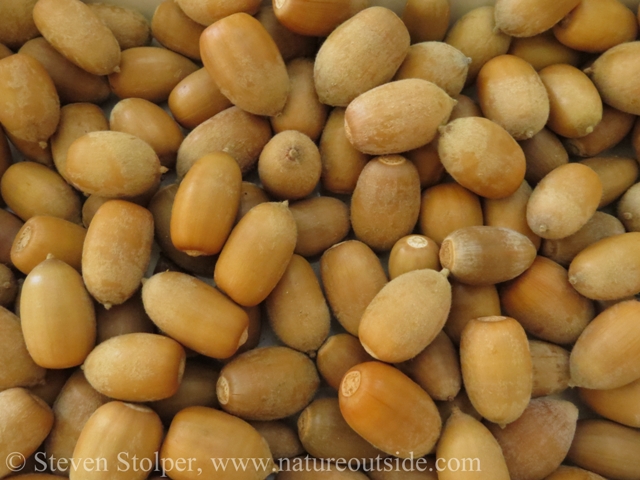
Tan Oak Acorns
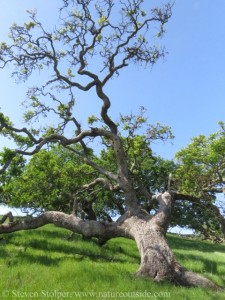
Valley Oak on Hillside
We conclude our “Acorn Trilogy” by learning to use water and gravity to transform the bitter nutmeats into nutritious and filling food.
In Part 1, we reviewed the steps required to process acorns. We learned about acorn nutrition, and how to harvest and store them. Part 2 discussed the equipment we need and how to shell and grind acorns. We learned about tannins, and why we must remove them from the acorns before we can use the nuts as food.
Leaching
Now the fun begins!
My leaching apparatus is very simple and inexpensive. You only have to create it once, and you can use it over and over. I cut the top off a plastic water jug very close to the top, before it begins to taper to the opening. I do this with a knife or scissors. The next step requires an inexpensive metal strainer. They are sold for a couple of dollars in most supermarkets. I use a conical one because they seem to work better than the semi-circular strainers. The strainer should be large enough that you can place it over the hole you have cut in the plastic jug. The strainer should rest on the top of the jug. Many have a “loop” to hang the strainer that conveniently hooks over the rim of the jug.
In the strainer, place a disposable coffee filter. These are commonly available and extremely inexpensive. One bag of filters will practically last a lifetime. You can use conical filters for conical strainers, or the “standard” filters with the semi-circular strainers.
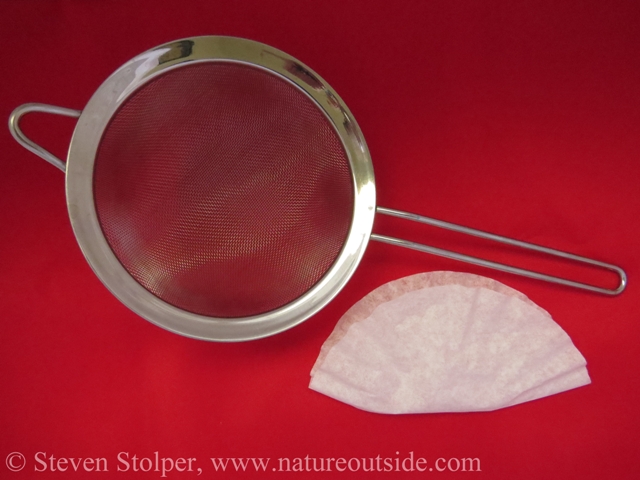
Semi-circular strainer with coffee filter
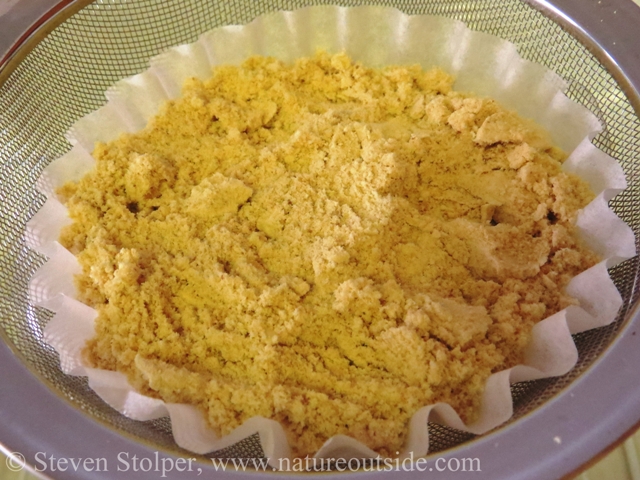
Acorn meal before leaching
As you remove ground acorn from the grinder, transfer the flour to the coffee filter. When the strainer/filter is almost full, you have about 1 cup of acorn flour. Leave a little space between the top of the coffee filter and the highest point of your pile of acorn flour.
Fill a plastic pitcher full of water. Then, gently pour the water over the acorn flour until the water line rises to the top of the coffee filter. You will see water begin to flow out the bottom of the strainer. This water will be orange/brown colored by the tannins leaching from the acorn. As the water level recedes, add more water from the pitcher.
At first, the water will be solidly orange-brown. The water will flow quickly through the acorn. As you progress, you will notice that the water takes more time to run through the acorn and eventually starts dripping from the bottom of the strainer. At this point, you can pour the water and walk away to do other chores. Return every 15-20 minutes depending on your drain rate to “freshen up” the water supply.
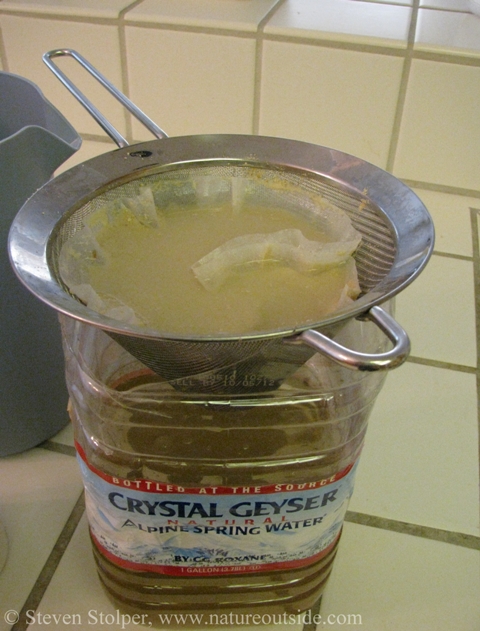
The tannic acid stains the water orange/brown as it drains through the acorn flour
When the 1 gallon jug fills with orange water, I empty the jug down the drain. There are other uses to which you can put the water, but they are beyond the scope of this article. Eventually, you will see the water in the jug running clear. When this happens depends on the tannin content of your acorns and how finely you ground them. I commonly see tanoak acorns, which contain a lot of tannins, require a bit over 1.5 gallons to become palatable.
The acorn flour is now ready to use! You can use the flour immediately, or dry it in an oven or dehydrator to use later. Remove the acorn flour and dispose of the coffee filter. Wash the jug and strainer soon after use.
Cooking
In ancient times, it took about 7 hours of work to shell, grind, and leach the acorns. The flour would provide a family’s meals for several days. Traditional acorn dishes included mush, soups, and “breads”.
Traditional-Style Mush
The native peoples in my area consumed the leached acorn as a traditional mush. In order to prepare the mush, they placed the ground acorn meal into a tightly woven basket that was water-tight. After adding water to the flour, they cooked the mixture with hot rocks, heated over a fire. The rocks were removed from the fire, dipped into water to clean them of ash, and placed into the basket.
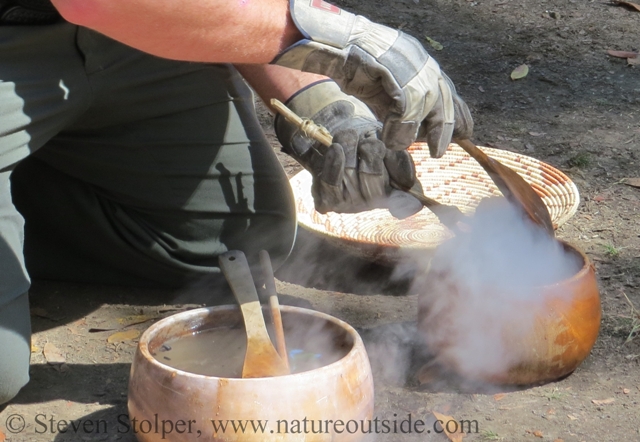
Cooking with rocks using modern wood bowls
You can replicate this approach in your modern kitchen. To prepare the mush, place the acorn flour into a pan with a relatively small amount of water. Heat (simmer not boil) the mixture over a burner on the kitchen stove. Stir while heating. When it is hot and has a consistency you like, it is ready.
I suggest you try the traditional-style mush to get the full taste of the acorns. I find that the mush has a “nutty” taste and is extremely filling. I can feel (taste?) the energy when I consume it. But acorn meal tastes bland on its own. So add a mix of spices to the mush to make it either savory or sweet. Decide how you like it best.
Embrace the Taste
Foods that are different from what we are accustomed to eating will seem “strange” in taste and appearance. But part of enjoying wild foods is experiencing tastes that are not normally part of our diet.
Eating acorn mush may seem unusual at first. But try serving it with vegetables or other wild foods. It is a chance to broaden your concept of “food.”
Modern Recipes
I also use the acorns in recipes along with wheat flour. I replace much of the wheat flour with acorn. In another article, I will describe how to make my favorite, Orange-acorn bread. It’s amazing!!! 🙂
There are also recipes online and in books for acorn cookies, soups, and even acorn mousse! Here are two books I like that are available on Amazon (these are affiliate links):
 Acorns and Eat’em: A How-To Vegetarian Acorn Cookbook, Suellen Ocean
Acorns and Eat’em: A How-To Vegetarian Acorn Cookbook, Suellen Ocean
 Acorn: Recipes for the Forgotten Food: 25 Nutritious, Delicious & Easy Recipes to Bring Acorn Back into Your Kitchen, Julie Martin and Eddie Starnater
Acorn: Recipes for the Forgotten Food: 25 Nutritious, Delicious & Easy Recipes to Bring Acorn Back into Your Kitchen, Julie Martin and Eddie Starnater
Each winter I experiment with new acorn recipes. So use your imagination! If you discover something that works, please post a comment below and tell me about it.
A Gentle Reminder
Please be responsible when you harvest acorns.
I have been a little hesitant to post information on acorn processing. I am concerned that too many people harvesting acorns will impact wildlife, much of which relies on acorns for food. This is a real concern for metropolitan areas (where I live). A small fraction of the human population harvesting acorns could easily consume an entire crop. It has also become fashionable in my area to incorporate wild foods into restaurant menus. Modern humans no longer rely on acorns for survival. But the animal population still does.
Oak trees have a survival strategy of not producing acorns in some years to reduce the population of animals that prey on them. These lean times are often followed by “mast years” when acorns are abundant. This cycle moves from location to location. Be attentive to this so you do not over-harvest when wildlife needs the food source the most.
Remember, the forest will supply our needs, but not our greeds.
Conclusion
Congratulations on your first journey into processing acorns. Gathering, processing, and preparing acorns can be incorporated into your yearly cycle. It is a reminder of the passing of the seasons – and the onset of autumn. So gather responsibly, and let acorns bring you closer to nature.
Best wishes and enjoy!
Here are the other articles in this series:
Part 1: Nutrition, Steps, Harvesting, and Storing
Part 2: Equipment, Shelling, Tannins, and Grinding
How to Make Orange Acorn Bread
For fun facts and useful tips, join the free Bushcraft Newsletter.


Hello I was wondering if you can tell me what uses the water from the leeching process of the acorns has
I would like to try this but I like to make use of the whole process and not waste anything
Thanks
Hi Tom!
The traditional use of tannic acid solution is to tan hides into leather. This is how vegetable tanned leather is made. It is the only use of tannic acid that I can recommend.
Tannic acid can also be used as a mordant for dyeing cotton. But I know very little about how to use it.
There is information on the internet describing topical and internal uses of tannic acid solution as a medicinal. But I caution against these uses. I cannot vouch for their safety. For topical use as an astringent or anti-fungal, there are commercial products that function as well and are FDA approved as safe.
I cannot recommend any of the internal uses you will find floating around the internet. The idea of using tannic acid internally makes me wince. Tannins are a plant’s defense mechanism. They bind to and precipitate proteins and various other organic compounds including amino acids and alkaloids. This chemical action is what turns a hide into leather. The last thing I would want to do is “tan” the inside of my stomach. Not surprisingly, ingesting large amounts of tannic acid can cause stomach irritation, nausea, vomiting, and liver damage.
So tanning leather and helping to dye cotton are the only uses I can suggest. You may be able to unearth others. My recommendation is to avoid the ones that use it as a medicinal.
– Steve
I am very surprised by good taste of coffee from acorns. Recently did this myself how it tastes and it is quite good. I’ll take inventory of her home. Interestingly there are several recipes for her [broken link removed] but do not know what is the best, maybe preferable to try to do them all. Can someone already knows best?
This is very interesting, Sandra! I have never tried to make coffee from acorns. I’ll look for a good recipe and try it on my friends to see what they think.